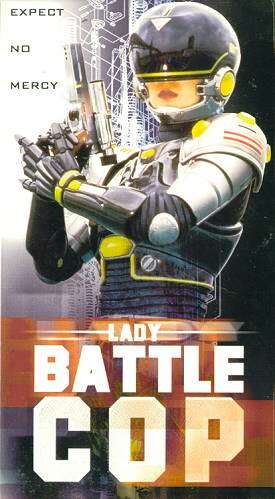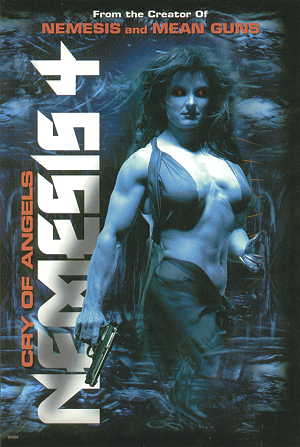 ★★★★
★★★★
“Play it again, Pam…”
 When I picked up this DVD, I could hear Chris rolling her eyes at me. And during the first five minutes of the movie – which consists of virtually nothing but Pam on a swing, getting sprayed with a fire-hose, silicone on display – this eye-rolling escalated to the point where I swear I could hear them whirring like the reels on a slot-machine. But by the end, even she had to admit that being a titty-fest – and there’s hardly a scene here without cleavage – doesn’t necessarily make this a bad movie…
When I picked up this DVD, I could hear Chris rolling her eyes at me. And during the first five minutes of the movie – which consists of virtually nothing but Pam on a swing, getting sprayed with a fire-hose, silicone on display – this eye-rolling escalated to the point where I swear I could hear them whirring like the reels on a slot-machine. But by the end, even she had to admit that being a titty-fest – and there’s hardly a scene here without cleavage – doesn’t necessarily make this a bad movie…
For this is nowhere near as bad as its Gigli-like reputation would have you believe. Okay, for $18m, you might expect a bit more than a post-Mad Max setting, and you would certainly expect more from your screenwriter than a blatant steal from Casablanca – Ilene Chaiken should be drummed out of the WGA for claiming a story credit here. But this is an adaptation of a comic-book, starring Pamela Anderson (Lee, as she was then known): what do you expect? I venture to suggest that, if I was 15, this would probably be the greatest story ever told.

Barb Wire runs a club called the Hammerhead in Steel Harbour, one of the last bastions of freedom in 2017 America, where a civil war is ongoing. She funds the club by catching bail-jumpers and rescuing kidnap victims (inevitably, posing as a stripper or hooker), and has to deal with all sides to keep the venue open. But when her former lover Axel (Morrison) turns up, with his new wife, who desperately needs out, her position on the fence suddenly becomes untenable, and she has to choose which side she’s really on.
For those who know Casablanca, almost every element appears in that Bogart classic:
| Element |
Casablanca |
Barb Wire |
| Setting |
Casablanca |
Steel Harbor |
| Era |
World War Two |
Second American Civil War |
| Enemy |
Nazis |
Congressional Directorate |
| Hero |
Rick Blaine |
Barb Wire |
| [A cynical expatriate who owns a bar and plays both sides] |
| Former lover |
Ilsa |
Axel |
| Now wedded to |
Victor Laszlo |
Cora D |
| Who needs… |
Exit visas |
Contact lenses |
| [Which let the bearer escape to safety] |
| Location |
Rick’s Bar |
The Hammerhead |
| Head Waiter |
Carl |
Curly |
| Chief Villain |
Major Strasser |
Colonel Pryzer |
| Top Cop |
Louis Renault |
Alexander Willis |
| Slimy dealer |
Guillermo Ugarte |
Schmitz |
| Mr. Big |
Signor Ferrari |
Big Fatso |
About the only new facet is Barb’s blind brother (Noseworthy) – it’s a shame he doesn’t play the piano, though he does act as Barb’s conscience. This concept, turning one of the most beloved Hollywood films of all time into a post-apocalyptic cheesecake-fest, is worth the price of admission alone, simply for its surrealness and sheer audacity. What next? Britney Spears as the lead in a remake of It’s a Wonderful Life?
 While one might question Pam’s acting talents, she is backed by a sterling cast of character actors: Steve Railsback, Xander Berkeley, Clint Howard, Udo Kier and Temuera Morrison. Each one hits the mark in their role, delivering lines with the correct level of enthusiasm. Kier, as usual, steals the show (his presence definitely helped soothe Chris’s eye-rolling), though Berkeley’s sleazy cop is perhaps the biggest surprise, especially if you’re only familiar with him as Jack Bauer’s boss in the first two seasons of 24.
While one might question Pam’s acting talents, she is backed by a sterling cast of character actors: Steve Railsback, Xander Berkeley, Clint Howard, Udo Kier and Temuera Morrison. Each one hits the mark in their role, delivering lines with the correct level of enthusiasm. Kier, as usual, steals the show (his presence definitely helped soothe Chris’s eye-rolling), though Berkeley’s sleazy cop is perhaps the biggest surprise, especially if you’re only familiar with him as Jack Bauer’s boss in the first two seasons of 24.
Credit should also go to Debbie Evans, Anderson’s stunt double, since it’s fairly obvious that Anderson, while having an undeniable presence (albeit a presence severely diluted whenever she opens her mouth for more than a one-liner – not that this ever stopped Van Damme, Stallone, or even Governor Arnie), is not doing her own stunts. Despite this, the action in the movie is well above-average, with some really cool explosions and fights, notably Axel’s battle a long way off the ground.
Certainly, Barb’s psychotic opposition to being called “babe” seems somewhat hypocritical given how she dresses. And really, despite the, ahem, “inspiration”, the plotting is a lot less fluid than you’d hope, with scenes that come out of and/or go nowhere. Just keep an eye on the contact lenses – alternatively, a familiarity with Casablanca will help you keep things straight and ignore the irrelevant threads.
 I admit, you could argue the entire story is irrelevant, and this is nothing more than an indefensible cocktail of eroticized violence. But those who live in such a moral vacuum as to require Hollywood to fill in the gaps, have got much bigger problems than Pamela Anderson’s breasts. If you can get past the first five minutes (which even I will say seem a lot longer), there’s no denying the effort expended here – albeit mostly on sex and violence, aimed at the lizard section of the viewer’s brain.
I admit, you could argue the entire story is irrelevant, and this is nothing more than an indefensible cocktail of eroticized violence. But those who live in such a moral vacuum as to require Hollywood to fill in the gaps, have got much bigger problems than Pamela Anderson’s breasts. If you can get past the first five minutes (which even I will say seem a lot longer), there’s no denying the effort expended here – albeit mostly on sex and violence, aimed at the lizard section of the viewer’s brain.
Yet curiously, actual sex doesn’t seem to take place in this universe at all, having apparently been replaced by tight-fitting costumes: claiming it’s a comment on life in a post-AIDS world is likely more credit than it deserves. Still, probably not a date movie (except in our house!), for this is trash, with hardly a thought in its vapid little head or 17-inch waist, and no agenda worth mentioning. Film doesn’t always need to be great art, any more than music; reprising the Britney motif, Barb Wire is equivalent to something like Hit Me Baby One More Time.
Perhaps the best comment comes from the Screen It website of parental reviews: “Topics to talk about – none”. There are times when this is a glowing recommendation for a movie, and at those times (probably a late weekend night, with a well-stocked fridge), Barb Wire fits the bill admirably.
Dir: David Hogan
Star: Pamela Anderson, Steve Railsback, Temuera Morrison, Jack Noseworthy

 The picture on the right probably does a better job of explaining what Cutey Honey is about than I ever could; part-girl, part nano-technology, rebuilt post-car crash with superpowers and some interesting costumes, which require fuelling through junk food. After her uncle is kidnapped by the evil Sister Jill (Sakai) and his/her/its minions – Jill is part tree, and has also been kidnapping women en masse, in order to drain their lifeforce – only Cutie (Sato) can save the day, assisted by a no-nonsense policewoman (Ichikawa) and a journalist who, basically, acts as “Exposition-San” (Murakami).
The picture on the right probably does a better job of explaining what Cutey Honey is about than I ever could; part-girl, part nano-technology, rebuilt post-car crash with superpowers and some interesting costumes, which require fuelling through junk food. After her uncle is kidnapped by the evil Sister Jill (Sakai) and his/her/its minions – Jill is part tree, and has also been kidnapping women en masse, in order to drain their lifeforce – only Cutie (Sato) can save the day, assisted by a no-nonsense policewoman (Ichikawa) and a journalist who, basically, acts as “Exposition-San” (Murakami).




 Watching the unstoppable female killing machine in this 1988 Indonesian film might make Terminator 3 seem less original – except most of the concept here, as well as entire scenes and exact lines of dialogue, come directly from the
Watching the unstoppable female killing machine in this 1988 Indonesian film might make Terminator 3 seem less original – except most of the concept here, as well as entire scenes and exact lines of dialogue, come directly from the  It’d probably be best to watch the original film, Poly Matrix, immediately before this, as otherwise, you’ll be kinda hitting the ground running. After those events, Ross Syllabus and “Third” [a model of android which can reproduce] Armitage have set up home with their daughter, who doesn’t know her mother is anything by human; meanwhile Ross operates under an assumed name as a security guard. However, an incident turns him into an unwilling spokesman for robot rights once again, and when he is sent to Earth as a Martian delegate, his daughter Yoko is kidnapped by a faction seeking to reverse his vote. It’s time for Armitage to put aside her chores and kick butt.
It’d probably be best to watch the original film, Poly Matrix, immediately before this, as otherwise, you’ll be kinda hitting the ground running. After those events, Ross Syllabus and “Third” [a model of android which can reproduce] Armitage have set up home with their daughter, who doesn’t know her mother is anything by human; meanwhile Ross operates under an assumed name as a security guard. However, an incident turns him into an unwilling spokesman for robot rights once again, and when he is sent to Earth as a Martian delegate, his daughter Yoko is kidnapped by a faction seeking to reverse his vote. It’s time for Armitage to put aside her chores and kick butt. Do
Do  As a rule, we don’t watch dubbed anime, finding it a painful experience; unfortunately, this version, which compacts four OAVs into a feature, is
As a rule, we don’t watch dubbed anime, finding it a painful experience; unfortunately, this version, which compacts four OAVs into a feature, is  At least, so claims one of the songs in this largely ineffective movie, about professional tennis starlet Kaoru – Anna Kournikova will be in the Hollywood remake, no doubt – who is transformed into a crime-fighting machine. This takes place after she is killed by the Cartel, a crime syndicate bent on taking over Japan, despite apparently having about seven members. They do, however, have a “psychic robot” called Amadeus, which is probably the sole original thought in the entire film, and the whole thing gets kicked up a notch during his battles. The interesting question of where he came from (apparently a NASA creation), is never explored. This is a shame, since it’d be rather more interesting than almost anything the film actually offers.
At least, so claims one of the songs in this largely ineffective movie, about professional tennis starlet Kaoru – Anna Kournikova will be in the Hollywood remake, no doubt – who is transformed into a crime-fighting machine. This takes place after she is killed by the Cartel, a crime syndicate bent on taking over Japan, despite apparently having about seven members. They do, however, have a “psychic robot” called Amadeus, which is probably the sole original thought in the entire film, and the whole thing gets kicked up a notch during his battles. The interesting question of where he came from (apparently a NASA creation), is never explored. This is a shame, since it’d be rather more interesting than almost anything the film actually offers. Though I hope 80’s hair
Though I hope 80’s hair  Though the lead actress, body-builder Sue Price, looks nothing like the cover pic (right), credit is due for choosing someone who defies conventional standards of female beauty. However, take all the points away, and then some, for pretending she does; having her spend half the film naked is something both Chris and I could very easily have lived without. She is, frankly, scary. That’s a shame, as while the budget here was obviously tiny, it’s put (mostly) to good use, with an interesting script.
Though the lead actress, body-builder Sue Price, looks nothing like the cover pic (right), credit is due for choosing someone who defies conventional standards of female beauty. However, take all the points away, and then some, for pretending she does; having her spend half the film naked is something both Chris and I could very easily have lived without. She is, frankly, scary. That’s a shame, as while the budget here was obviously tiny, it’s put (mostly) to good use, with an interesting script.



 While one might question Pam’s acting talents, she is backed by a sterling cast of character actors: Steve Railsback, Xander Berkeley, Clint Howard, Udo Kier and Temuera Morrison. Each one hits the mark in their role, delivering lines with the correct level of enthusiasm. Kier, as usual, steals the show (his presence definitely helped soothe Chris’s eye-rolling), though Berkeley’s sleazy cop is perhaps the biggest surprise, especially if you’re only familiar with him as Jack Bauer’s boss in the first two seasons of 24.
While one might question Pam’s acting talents, she is backed by a sterling cast of character actors: Steve Railsback, Xander Berkeley, Clint Howard, Udo Kier and Temuera Morrison. Each one hits the mark in their role, delivering lines with the correct level of enthusiasm. Kier, as usual, steals the show (his presence definitely helped soothe Chris’s eye-rolling), though Berkeley’s sleazy cop is perhaps the biggest surprise, especially if you’re only familiar with him as Jack Bauer’s boss in the first two seasons of 24. I admit, you could argue the entire story is irrelevant, and this is nothing more than an indefensible cocktail of eroticized violence. But those who live in such a moral vacuum as to require Hollywood to fill in the gaps, have got much bigger problems than Pamela Anderson’s breasts. If you can get past the first five minutes (which even I will say seem a lot longer), there’s no denying the effort expended here – albeit mostly on sex and violence, aimed at the lizard section of the viewer’s brain.
I admit, you could argue the entire story is irrelevant, and this is nothing more than an indefensible cocktail of eroticized violence. But those who live in such a moral vacuum as to require Hollywood to fill in the gaps, have got much bigger problems than Pamela Anderson’s breasts. If you can get past the first five minutes (which even I will say seem a lot longer), there’s no denying the effort expended here – albeit mostly on sex and violence, aimed at the lizard section of the viewer’s brain.